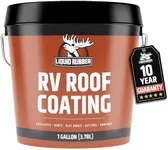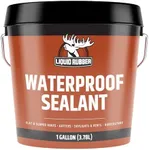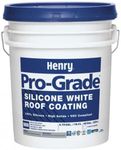Buying Guide for the Best Roof Sealant
Choosing the right roof sealant is crucial for protecting your home from leaks, weather damage, and extending the life of your roof. The right sealant will depend on the type of roof you have, the climate you live in, and the specific needs of your roof. Here are some key specifications to consider when selecting a roof sealant.Type of SealantRoof sealants come in various types such as acrylic, silicone, polyurethane, and rubber. Each type has its own advantages and is suitable for different kinds of roofs. Acrylic sealants are water-based and easy to apply, making them great for DIY projects. Silicone sealants are highly durable and resistant to weathering, ideal for areas with extreme temperatures. Polyurethane sealants offer excellent adhesion and flexibility, suitable for metal roofs. Rubber sealants provide a strong, waterproof barrier and are often used for flat roofs. Choose the type that best matches your roof material and environmental conditions.
DurabilityDurability refers to how long the sealant will last and how well it can withstand various weather conditions. This is important because a more durable sealant will provide longer-lasting protection for your roof. Durability can be influenced by the type of sealant and the quality of the product. Generally, silicone and polyurethane sealants are known for their high durability, while acrylic sealants may need more frequent reapplication. Consider the climate in your area; if you experience harsh weather conditions, opt for a more durable sealant.
UV ResistanceUV resistance is the sealant's ability to withstand damage from the sun's ultraviolet rays. This is important because UV rays can cause sealants to degrade over time, leading to cracks and leaks. Sealants with high UV resistance will last longer and provide better protection. Silicone and polyurethane sealants typically offer excellent UV resistance. If your roof is exposed to a lot of direct sunlight, prioritize a sealant with strong UV resistance to ensure longevity.
FlexibilityFlexibility refers to the sealant's ability to expand and contract with temperature changes without cracking. This is crucial for roofs in areas with significant temperature fluctuations. Flexible sealants can accommodate the natural movement of the roof materials, preventing cracks and leaks. Silicone and rubber sealants are known for their high flexibility. If you live in a region with wide temperature variations, choose a sealant with good flexibility to maintain a strong, unbroken seal.
Application MethodThe application method of the sealant can affect the ease and effectiveness of the sealing process. Some sealants come in a liquid form that can be applied with a brush or roller, while others are available in a caulk-like form for use with a caulking gun. Liquid sealants are generally easier to apply over large areas, while caulk-like sealants are better for sealing specific joints and cracks. Consider your comfort level with the application process and the specific needs of your roof when choosing the application method.
Drying TimeDrying time is the amount of time it takes for the sealant to cure and become effective. This is important because a faster drying time can be beneficial if you need to complete the project quickly or if there is a risk of rain. However, some high-quality sealants may take longer to dry but offer better performance and durability. If you need a quick fix, look for a sealant with a shorter drying time. For long-term projects, a longer drying time may be acceptable if it means better results.













![IMPRESA Reusable Sealer Applicator Pads [4 Pack] - Advanced Microfiber Cleaning Cloth Ideal for Tile, Grout, Marble, Granite, Slate, Travertine, and Natural Stone Surfaces (5 x 4 x 1 in)](https://images-proxy.bestreviews.guide/Lax2PF3jzaSPsfZxdPmukZkrmA0=/0x150/https://m.media-amazon.com/images/I/51pFrtqMwmL._AC_CX679_.jpg)








